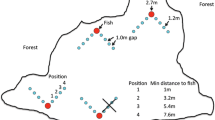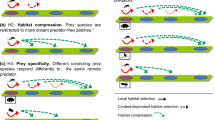Abstract
Evidence has accumulated that colonization of new habitats by aquatic insects is often selective rather than random. However, it is still unclear how habitat selection changes during a colonization sequence. We studied colonization of adult aquatic beetle and bug communities in cattle tanks exposed to fish predation or predation risk repeatedly over time. This allowed us to quantify the relative importance of habitat selection and consumption by a predator on communities. Habitat selection explained about 25 and 43% of the total predator effect on the final species richness and abundance, respectively. While other studies on fish cues affecting beetle colonization typically found effects on species richness in the first 3 weeks, we only saw a response after 6 weeks. The observed slower and weaker effects of predation risk on habitat selection by adults in the current study, conducted after the reproduction phase of aquatic beetles and bugs, might be due to seasonal variation in the response to predation risk. The relative importance of predation risk as a driver for habitat selection might be lower outside the reproduction period when the most vulnerable life stages are absent.

Aerial view (bottom left) taken from www.luchtvaarterfgoed.be, with permission from ©Bart Beckers


Similar content being viewed by others

References
Åbjörnsson, K., B. M. A. Wagner, A. Axelsson, R. Bjerselius & K. H. Olsén, 1997. Responses of Acilius sulcatus (Coleoptera: Dytiscidae) to chemical cues from perch (Perca fluviatilis). Oecologia 111: 166–171.
Åbjörnsson, K., C. Bronmark & L. A. Hansson, 2002. The relative importance of lethal and non-lethal effects of fish on insect colonisation of ponds. Freshwater Biology 47: 1489–1495.
Baines, C. B., S. J. McCauley & L. Rowe, 2014. The interactive effects of competition and predation risk on dispersal in an insect. Animal Behaviour 210: 3236–3244.
Baines, C. B., S. J. McCauley & L. Rowe, 2015. Dispersal depends on body condition and predation risk in the semi-aquatic insect, Notonecta undulata. Ecology and Evolution 5: 2307–2316.
Baker, R. R., 1978. The evolutionary ecology of animal migration. Hodder & Stoughton, London.
Barton, B. T., 2010. Climate warming and predation risk during herbivore ontogeny. Ecology 91: 2811–2818.
Bell, R. D., A. L. Rypstra & M. H. Persons, 2006. The effect of predator hunger on chemically mediated antipredator responses and survival in the wolf spider Pardosa milvina (Araneae: Lycosidae). Ethology 112: 903–910.
Binckley, C. A. & W. J. Resetarits, 2005. Habitat selection determines abundance, richness and species composition of beetles in aquatic communities. Biology Letters 1: 370–374.
Blaustein, L., M. Kiflawi, A. Eitam, M. Mangel & J. E. Cohen, 2004. Oviposition habitat selection in response to risk of predation in temporary pools: mode of detection and consistency across experimental venue. Oecologia 138: 300–305.
Blaustein, J., A. Sadeh & L. Blaustein, 2014. Influence of fire salamander larvae on among-pool distribution of mosquito egg rafts: oviposition habitat selection or egg raft predation? Hydrobiologia 723: 157–165.
Boda, P. & Z. Csabai, 2013. When do beetles and bugs fly? A unified scheme for describing seasonal flight behaviour of highly dispersing primary aquatic insects. Hydrobiologia 703: 133–147.
Brodin, T., F. Johansson & J. Bergsten, 2006. Predator related oviposition site selection of aquatic beetles (Hydroporus spp.) and effects on offspring life-history. Freshwater Biology 51: 1277–1285.
Creel, S. & D. Christianson, 2008. Relationships between direct predation and risk effects. Trends in Ecology and Evolution 23: 194–201.
Drost, B., H. Cuppen, E. van Nieukerken & M. Schreijer, 1992. De waterkevers van Nederland. KNNV Uitgeverij, Utrecht.
Florencio, M., C. Diaz-Paniagua, C. Gómez-Rodriguez & L. Serrano, 2014. Biodiversity patterns in a macroinvertebrate community of a temporary pond network. Insect Conservation and Diversity 7: 4–21.
Fretwell, S. D. & H. L. Lucas, 1969. On territorial behavior and other factors influencing habitat distribution in birds. Acta Biotheoretica 19: 16–36.
Garcia, E. A. & G. G. Mittelbach, 2008. Regional coexistence and local dominance in Chaoborus: species sorting along a predation gradient. Ecology 89: 1703–1713.
Hammill, E., T. B. Atwood & D. S. Srivastava, 2015. Predation threat alters composition and functioning of bromeliad ecosystems. Ecosystems 18: 857–866.
Kraus, J. M. & J. R. Vonesh, 2010. Feedbacks between community assembly and habitat selection shape variation in local colonization. Journal of Animal Ecology 79: 795–802.
McCauley, S. J. & L. Rowe, 2010. Notonecta exhibit threat-sensitive, predator-induced dispersal. Biology Letters 6: 449–452.
Ohba, S. Y. & H. Takagi, 2005. Food shortage affects flight migration of the giant water bug Lethocerus deyrolli in the prewintering season. Limnology 6: 85–90.
Peckarsky, B. L., B. L. Kerans, B. W. Taylor & A. R. McIntosh, 2008. Predator effects on prey population dynamics in open systems. Oecologia 156: 431–440.
Petranka, J. W. & K. Fakhoury, 1991. Evidence of a chemically-mediated avoidance response of ovipositing insects to blue-gills and green frog tadpoles. Copeia 1991: 234–239.
Preisser, E. L., J. L. Orrock, O. J. Schmitz, L. Preisser, L. Orrock & J. Schmitz, 2007. Predator hunting mode and habitat domain alter nonconsumptive effects in predator–prey interactions. Ecology 88: 2744–2751.
Resetarits, W. J., 2001. Colonization under threat of predation: avoidance of fish by an aquatic beetle, Tropisternus lateralis (Coleoptera: Hydrophilidae). Oecologia 129: 155–160.
Resetarits, W. J. & C. A. Binckley, 2009. Spatial contagion of predation risk affects colonization dynamics in experimental aquatic landscapes. Ecology 90: 869–876.
Resetarits, W. J. & C. A. Binckley, 2013a. Is the pirate really a ghost? Evidence for generalized chemical camouflage in an aquatic predator, pirate perch Aphredoderus sayanus. The American Naturalist 181: 690–699.
Resetarits, W. J. & C. A. Binckley, 2013b. Patch quality and context, but not patch number, drive multi-scale colonization dynamics in experimental aquatic landscapes. Oecologia 173: 933–946.
Resetarits, W. J. & C. A. Binckley, 2014. Species responses of colonising beetles to variation in patch quality, number, and context in experimental aquatic landscapes. Ecological Entomology 39: 226–235.
Rosenzweig, M. L., 1991. Habitat selection and population interactions: the search for mechanism. The American Naturalist 137: S5–S28.
Sitvarin, M. I., A. L. Rypstra & J. D. Harwood, 2016. Linking the green and brown worlds through nonconsumptive predator effects. Oikos 125: 1057–1068.
Stauffer, H.-P. & R. D. Semlitsch, 1993. Effects of visual, chemical and tactile fish cues on behavioral responses of tadpoles. Animal Behaviour 46: 355–364.
Stoffelen, E., H. Henderickx, T. Vercauteren, K. Lock & R. Bosmans, 2013. De water—en oppervlaktewantsen van België. KBIN, Brussels.
Trekels, H., F. Van de Meutter & R. Stoks, 2013. Predator cues magnify effects of the pesticide endosulfan in water bugs in a multi-species test in outdoor containers. Aquatic Toxicology 138–139: 116–122.
Verreycken, H., D. Anseeuw, D. Thuyne, P. Quataert Van & C. Belpaire, 2007. The non-indigenous freshwater fishes of Flanders (Belgium): review, status and trends over the last decade. Journal of Fish Biology 71: 160–172.
Vonesh, J. R. & L. Blaustein, 2011. Predator-induced shifts in mosquito oviposition site selection: a meta-analysis and implications for vector control. Israel Journal of Ecology and Evolution 56: 263–279.
Wesner, J. S., E. J. Billman & M. C. Belk, 2012. Multiple predators indirectly alter community assembly across ecological boundaries. Ecology 93: 1674–1682.
Wesner, J. S., P. Meyers, E. J. Billman & M. C. Belk, 2015. Habitat selection and consumption across a landscape of multiple predators. Ecology and Evolution 5: 121–129.
Acknowledgments
We thank two anonymous reviewers for their contributions to improving the final manuscript substantially. We also thank the nature conservation organization Natuurpunt (section Hasselt-Zonhoven) for granting access to the Nature Reserve of Tommelen. HT is supported as a postdoctoral fellow by the Research Foundation - Flanders (FWO), Grant No. 12N0415N.
Author information
Authors and Affiliations
Corresponding author
Ethics declarations
Conflict of Interest
The authors declare that they have no conflict of interest.
Additional information
Handling editor: Lee B. Kats
Electronic supplementary material
Below is the link to the electronic supplementary material.
Rights and permissions
About this article
Cite this article
Trekels, H., Vanschoenwinkel, B. When fear kicks in: predator cues initially do not but eventually do affect insect distribution patterns in a new artificial pond cluster. Hydrobiologia 790, 157–166 (2017). https://doi.org/10.1007/s10750-016-3027-9
Received:
Revised:
Accepted:
Published:
Issue Date:
DOI: https://doi.org/10.1007/s10750-016-3027-9



